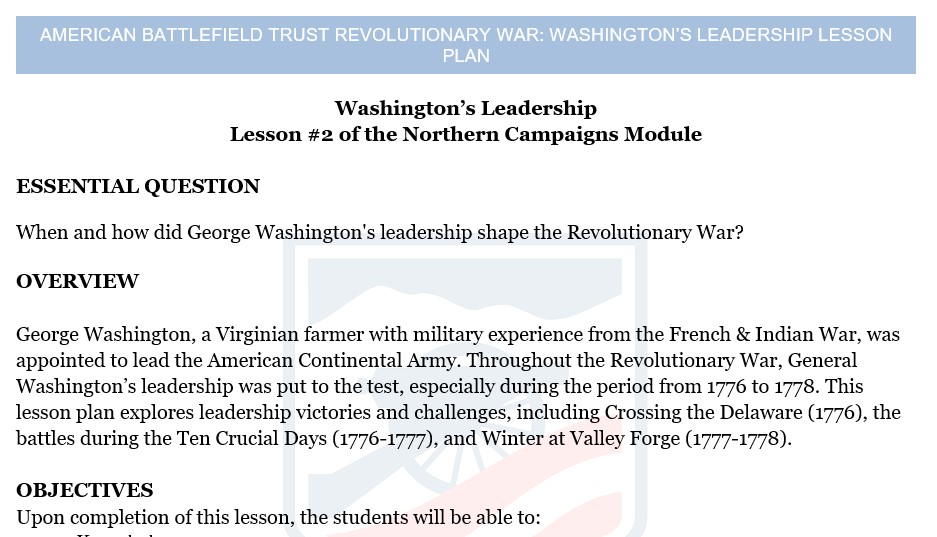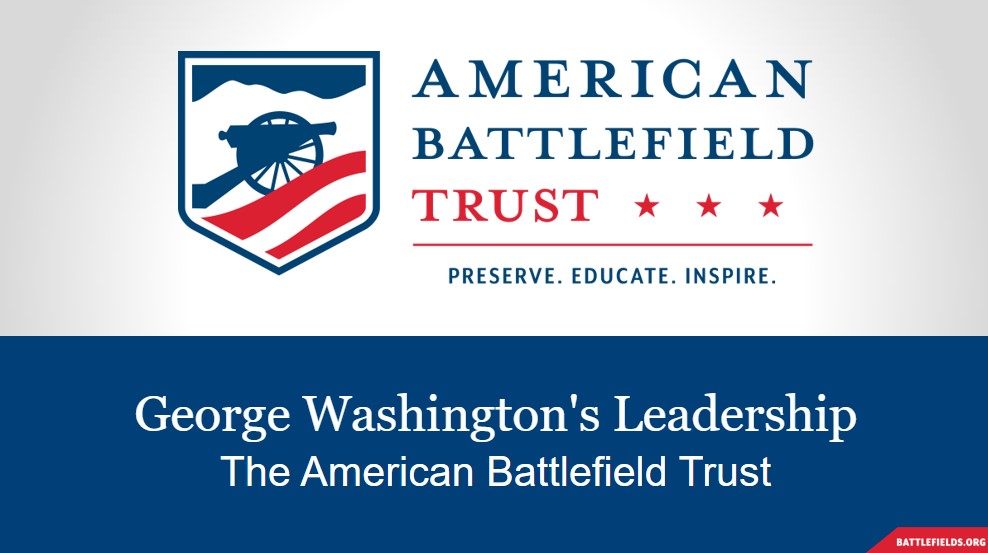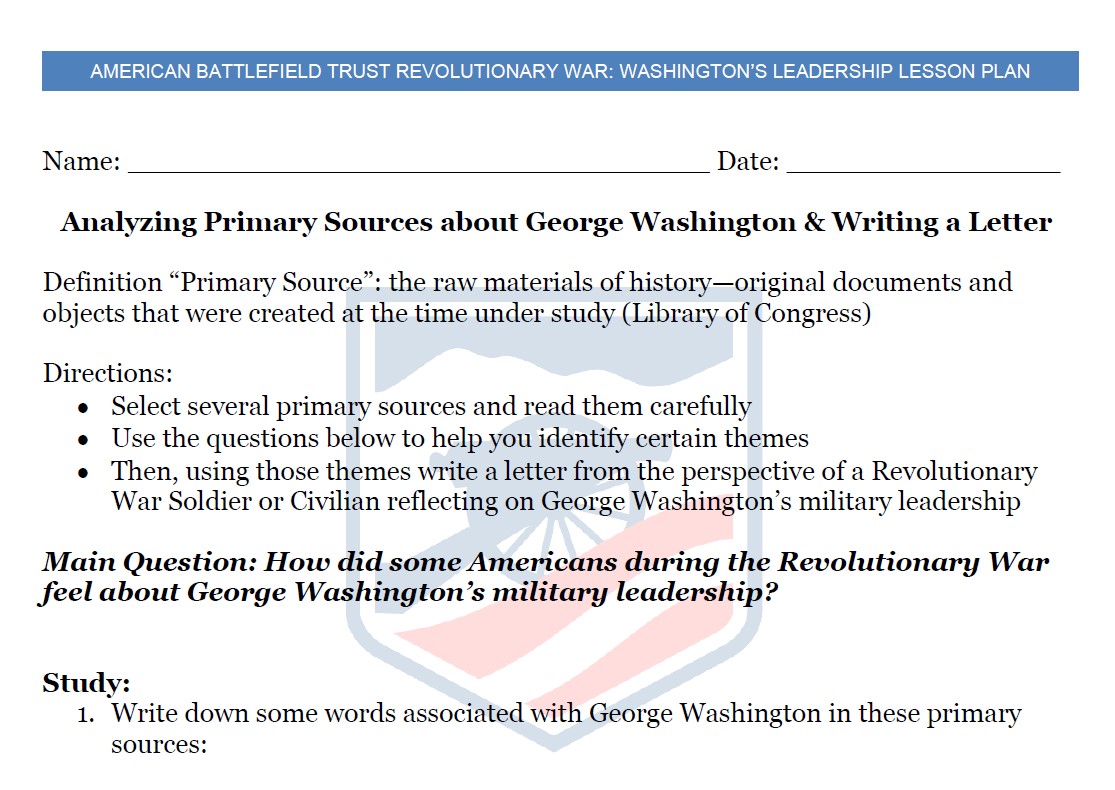
Washington at Valley Forge
Washington's Leadership Lesson Plan
A lesson plan for use in middle and high school classrooms.
George Washington, a Virginian farmer with military experience from the French & Indian War, was appointed to lead the American Continental Army. Throughout the Revolutionary War, General Washington’s leadership was put to the test, especially during the period from 1776 to 1778. This lesson plan explores leadership victories and challenges, including Crossing the Delaware (1776), the battles during the Ten Crucial Days (1776-1777), and Winter at Valley Forge (1777-1778).
This Lesson Plan can be used as a prepared resource by following this curriculum plan which aligns to NCSS and Common Core Standards.
This Lesson Plan's assets can also be used on their own as supplemental resources. The display format is prepared for easy access, exploring, and learning.
The Northern Campaigns Module
Upon completion of this lesson, the students will be able to:
1. Knowledge
- Describe some of George Washington’s military leadership moments, including Crossing the Delaware, Battle of Princeton, and Encampment at Valley Forge.
- Discuss people’s reactions to George Washington’s leadership during the Revolutionary War.
2. Comprehension/Application/Analysis
- Read and chart about primary source documents, then write a letter based on findings.
3. Evaluation
- Evaluate and discuss some of the difficult moments and victories of the Revolutionary War.
Check out the Lesson Plan Teaching Guide for more instructions on using the prepared Lesson Plan.
Lesson Plan Primary Source Activity
- Use the Lesson’s PowerPoint to explore the context and history; the PowerPoint introduces Essential Questions and lays foundational knowledge about the conflict.
- Watch these Videos
- Distribute the primary source worksheets and have the students several of the provided primary sources for this lesson.
- Students will write a letter based on their findings from the primary sources and their worksheet notes.
- 6 selected primary sources are available under the “Primary Source” section this lesson plan page.
OPTIONAL HOMEWORK/ASSESSMENT/ADDITIONAL ACTIVITIES:
Option 1: Ten Crucial Days Timeline
Students can watch the 2 minute video “The Ten Crucial Days.” On their own or as a class, create a timeline of this campaign that resulted in several important American victories. Use this article from American Battlefield Trust and this article/timeline from Washington Crossing Historical Park as a reference for each of the days. Create a timeline or a day-by-day calendar which can include illustrations, historic images, or photos.
- Monday, December 25, 1776
- Tuesday, December 26, 1776
- Wednesday, December 27, 1776
- Thursday, December 28, 1776
- Friday, December 29, 1776
- Saturday, December 30, 1776
- Sunday, December 31, 1776
- Monday, January 1, 1777
- Tuesday, January 2, 1777
- Wednesday, January 3, 1777
Option 2: Winter at Valley Forge
Have the students watch “Valley Forge In4” and read this primary source. Have students write newspaper headlines as though they are reporting on the following topics/conditions for the Continental Army during their Winter at Valley Forge.
- Food
- Shelter
- Weather
- George Washington’s reactions
- Learning military drill
- Why a soldier says he will stay in the army
Common Core State Standards- ELA & History/Social Studies
Grades 6-8
- Key Ideas and Details:
- CCSS.ELA-LITERACY.RH.6-8.2
- Determine the central ideas or information of a primary or secondary source; provide an accurate summary of the source distinct from prior knowledge or opinions.
- CCSS.ELA-LITERACY.RH.6-8.2
- Craft and Structure:
- CCSS.ELA-LITERACY.RH.6-8.6
- Identify aspects of a text that reveal an author's point of view or purpose (e.g., loaded language, inclusion or avoidance of particular facts).
- CCSS.ELA-LITERACY.RH.6-8.6
- Integration of Knowledge and Ideas:
- CCSS.ELA-LITERACY.RH.6-8.8
- Distinguish among fact, opinion, and reasoned judgment in a text.
- CCSS.ELA-LITERACY.RH.6-8.8
Grades 9-10
- Key Ideas and Details:
- CCSS.ELA-LITERACY.RH.9-10.2
- Determine the central ideas or information of a primary or secondary source; provide an accurate summary of how key events or ideas develop over the course of the text.
- CCSS.ELA-LITERACY.RH.9-10.2
- Craft and Structure:
- CCSS.ELA-LITERACY.RH.9-10.6
- Compare the point of view of two or more authors for how they treat the same or similar topics, including which details they include and emphasize in their respective accounts.
- CCSS.ELA-LITERACY.RH.9-10.6
- Integration of Knowledge and Ideas:
- CCSS.ELA-LITERACY.RH.9-10.8
- Assess the extent to which the reasoning and evidence in a text support the author's claims.
- CCSS.ELA-LITERACY.RH.9-10.8
Grades 11-12
- Key Ideas and Details:
- CSS.ELA-LITERACY.RH.11-12.2
- Determine the central ideas or information of a primary or secondary source; provide an accurate summary that makes clear the relationships among the key details and ideas.
- CSS.ELA-LITERACY.RH.11-12.2
- Craft and Structure:
- CCSS.ELA-LITERACY.RH.11-12.6
- Evaluate authors' differing points of view on the same historical event or issue by assessing the authors' claims, reasoning, and evidence.
- CCSS.ELA-LITERACY.RH.11-12.6
- Integration of Knowledge and Ideas:
- CCSS.ELA-LITERACY.RH.11-12.8
- Evaluate an author's premises, claims, and evidence by corroborating or challenging them with other information.
- CCSS.ELA-LITERACY.RH.11-12.9
- Integrate information from diverse sources, both primary and secondary, into a coherent understanding of an idea or event, noting discrepancies among sources.
- CCSS.ELA-LITERACY.RH.11-12.8
Social Studies - National Council for the Social Studies
- Theme 1: Culture
- Theme 2: Time, Continuity, and Change
- Theme 3: People, Places, and Environments
- Theme 4: Individual Development and Identity
- Theme 5: Individuals, Groups, and Institutions
- Theme 6: Power, Authority, and Governance
This Lesson plan
contains the following:
3 Activities | 25 Resources
Audience: Middle school | High school
This Lesson plan is a part of:
Revolutionary War Curriculum | The Northern Campaigns Module






